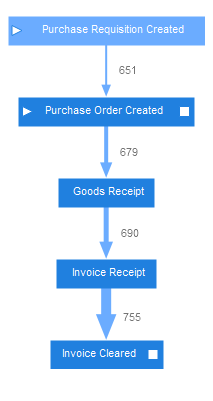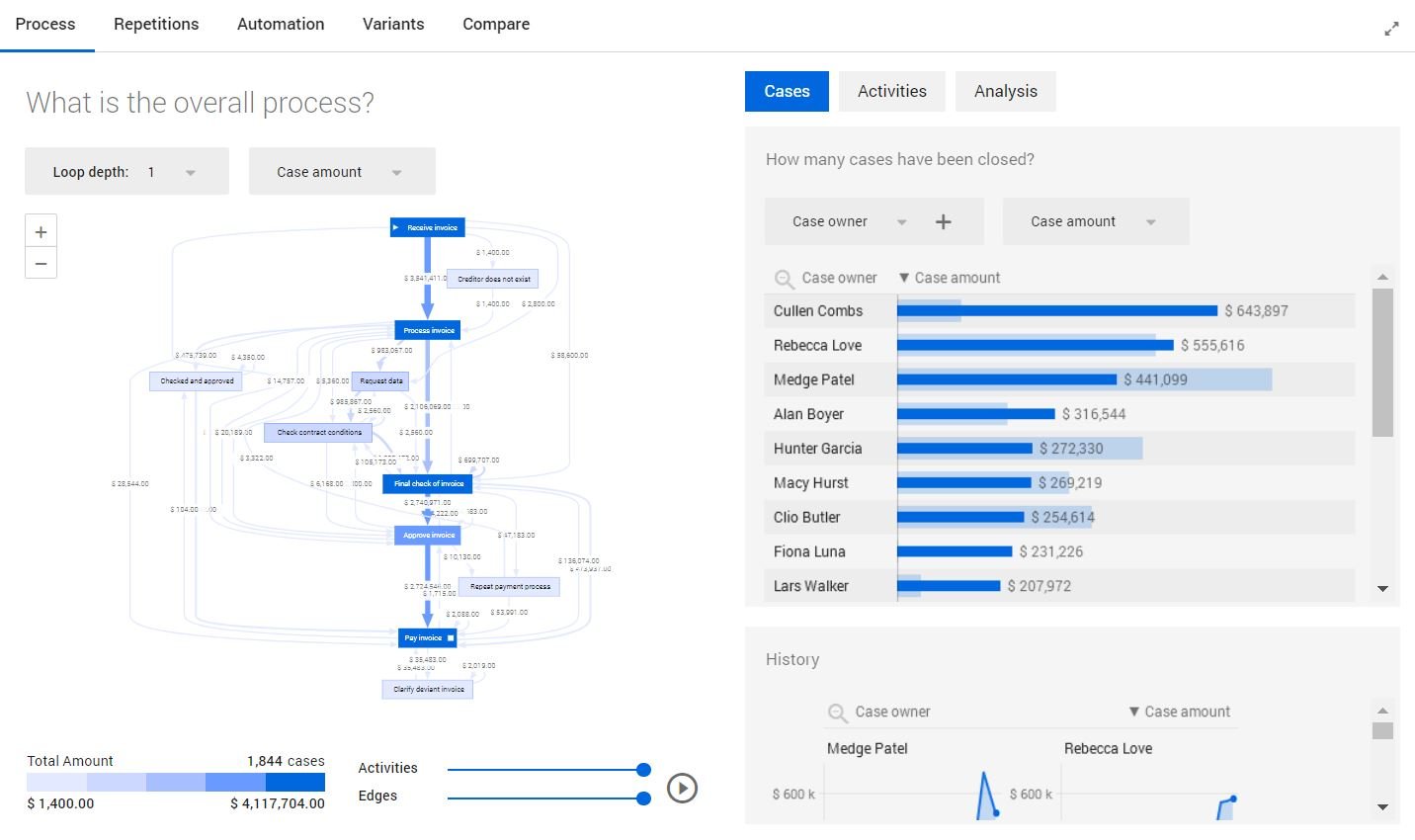How to Optimize a Purchase-to-Pay Process with Process Mining
Share at:

As humans, it’s in our nature to cooperate with each other. We can also compete, but psychologists say that when choosing between the two, we choose cooperation.
Cooperation is very important in the workplace. Working without it can have a negative impact on your wider business outcomes, including productivity, customer satisfaction, and revenue.
In theory, cooperation should be easy, especially if it’s in our human nature. But most humans know it takes a certain amount of dedication to cooperate in the workplace or daily life.
Each department and its individuals have very different targets, pain points, and goals. With no bad intention, everyone tends to think within their own domain. Poor cooperation often results in people and departments undertaking their own improvement initiatives. Decentralized initiatives can cause disturbances down the line for other departments.
Nowhere is this more evident than in the purchase-to-pay process.
The purchase-to-pay or procure-to-pay process (P2P) is a financial process that touches many departments. The process includes all the activities from the moment a company requests a good or service from a supplier, until it pays for that good or service.
The efficiency of the P2P process impacts customer satisfaction rates and costs, and influences your company’s ability to achieve wider business goals.
In this post, we are covering the advantages of optimizing the P2P process with help of data available in corporate systems (such as SAP or Oracle) and process mining. More specifically, UiPath Process Mining can help you improve the P2P process by laying out your existing data into a comprehensive process graph and providing transparent insights.
Having a better understanding of the P2P process allows you to decide on unified process improvement tactics through optimization and automation, which results in increased efficiency, decreased costs, and staying competitive.
The purchase-to-pay process
The P2P process involves all purchases a company makes. Those can be office stationery or semi-finished materials (like a car engine for a car manufacturing company) and high-value equipment (machinery used in production, medical equipment, etc.). Within the P2P process, core tasks include ordering those goods, receiving them, and paying for them.
The main stakeholders in the P2P process are the procurement or finance departments. Sometimes it also involves material planning and warehousing. The process also indirectly impacts work done by sales, customer support, and more.
The wide-reaching and critical nature of the P2P process means that there is a huge incentive for companies to optimize it. Any inefficient and rusty P2P process may result in a significant loss of value in the following areas:
Customer satisfaction
Supplier relationships
Employee job satisfaction
Interdepartmental collaboration
Productivity and profitability
Those are some of the most important goals for the business.
With UiPath Process Mining, it's possible to improve those points and reach higher business performance.
New to process mining? Start here: Process Mining Value: What it Means for Your Business
The process mining technology provides powerful insights. It is a gateway to technologies like machine learning (ML), artificial intelligence (AI), and robotic process automation (RPA). Combining these technologies allows you to harness the power of automation.
An enterprise relies on data to strategically improve processes with RPA and tracks results to come up with new improvement ideas. An automated enterprise leads the market with process awareness and operational efficiency. As part of the automation cycle, process mining plays critical roles at the start of RPA and at its further development. Process mining allows you to get move value from automations.
Process mining allows you to rely on science to discover and rank your automation ideas. It also enables you to:
Gain a comprehensive view of your company’s processes
Uncover the best workflows to automate
Align process goals with strategic goals
Continuously monitor and improve your processes
Know your P2P process inside out
Let’s look at a purchase-to-pay process graph.

The above image shows a mined P2P process (a raw dataset transformed into a process graph). It includes five core activities of a typical purchase-to-pay process:
Purchase request
Purchase order
Product receipt
Invoice receipt
Invoice completion
The image above shows the ideal P2P process.
UiPath Process Mining (available via the UiPath Platform) can give you a deeper look at your processes, and let you discover how far you are from the ideal scenario. Using event log data from an enterprise software such as SAP, process mining turns data into a clean process graph for intuitive analysis.
The deeper in the process graph you go, the more you’ll notice how different it is from how you want your process to be. As a result, the simple process from the above image turns out to be chaotic:

Intuitive process visualization tells you everything you want to know about the process and it acts as the one source of truth for your whole team. The process graph eliminates any process ambiguity, giving everyone a consolidated overview of activities, timings, costs, cooperation, human and software robot performance, etc.
Where previously you would need to spend time figuring out how the P2P process runs, UiPath Process Mining does this in an instant using actual data from enterprise resource planning (ERP) or customer relationship management (CRM) systems.
So, what can you do with these data-driven insights?
Identify parts of the purchase-to-pay process that are best suited for automation
Robotic process automation (RPA) is one of the most productive ways to improve efficiency and performance of your process. According to the Deloitte Global CPO Survey, the demand for RPA and advanced analytics in procurement is on the rise. RPA is not novel for productivity in accounts payable teams, but it can prosper more with process mining.
With process mining insights you can determine if your P2P process is ready for automation. An automation-ready process is a standardized process that aims at even higher productivity. UiPath Process Mining can point at some of the automation-readiness criteria like:
The high volume of repetitive rule-based tasks
The number of hours spent on tasks vs. costs
Delayed due dates
Process loops as a result of errors and the need to redo the task, etc.
A poorly designed or executed process is not ready for automation. Such process often lacks proper documentation, standardization, and is difficult for people to follow. Using process mining to guide your automation strategy you rely on data and not your gut feeling.
Read this post to evaluate whether your process is ready for automation.
UiPath Process Mining helps you consider the details of your complex P2P process and automate the activities with the highest return on investment (ROI).
Let’s think of an example: there is a process that you have mined. Based on the process graph, you notice that in one of the process activities employees don’t deliver their work on time. You dig deeper and realize that due to mistakes in data insertion employees often redo the task, which causes a delay in delivery. Automating this task, you improve the quality of delivered work and free up employees’ time. The team then can focus on other activities within the P2P process, such as improvement of supplier relationships to assure on-time delivery.
Here are some other examples of the tasks that UiPath software robots can handle to make your P2P process smoother:
Scanning a mailbox for orders and entering them in SAP
Matching the purchase order with the invoice
Generating purchase order after purchase requisition approval and more
With process mining, you can not only foresee improvement opportunities, but also to estimate the ROI from your RPA project. This way you know the value of the P2P process optimization in relation to the entire business performance.
Align your RPA goals with wider strategic goals
Remember the strategic goals we mentioned earlier? The key strategic goals of any company are built around customer satisfaction, supplier relationships, employee happiness, profitability, and productivity.
UiPath Process Mining helps you link your strategic goals to specific KPI’s and tags. If you want to improve supplier relationships for a P2P process, you could set a KPI for the timely delivery of goods and on-time invoice payments.
This way you optimize a process to contribute to your wider business goals in a skillful manner. As priorities change, you can adjust the KPI’s and tags in the UiPath Process Mining dashboards. This is yet another key factor in ensuring your long-term business goals align with your individual process outcomes.
Continuous monitoring and improvement of P2P
But process mining doesn’t stop there. Once you've automated the P2P process, you still need to check whether the RPA is progressing as expected. UiPath Process Mining allows you to stay on track on the automation results providing real-time updates on your process data. Tracking your process gives you a "before and after" RPA comparison. You can see how your automation is running and where it is going off course.
According to the CPO Survey by Deloitte mentioned earlier, the key challenge in today’s procurement is data governance – assuring quality of gathered data, managing data access, and getting value from that data.
To maintain data privacy while democratizing process analytics, UiPath Process Mining provides a governed self-service (GSS) approach. A GSS data management ensures all business users work with a single source of truth, making the process clear to all stakeholders.
In turn, GSS makes your process transparent, as it’s based on the actual data in your corporate systems. It’s hard to argue with facts. Transparent processes are key to achieving the wider business goals outlined before.
Continuous monitoring and improvement of P2P
Process mining provides a foundation for internal and external cooperation, which is crucial for a smooth P2P process. With UiPath Process Mining in place, you cut siloed operations between departments. As stakeholders gain the same idea of a process, they can take a holistic approach in their process improvement initiatives. And this works great with both internal and external process stakeholders.
Process mining allows the executive-level managers to identify inefficiency and align the process optimization with the business strategy. Employees performing the steps of a process also gain insight into their work and how it affects the organization.
You can also use the process graph to communicate with suppliers and investors. Process mining insights let you cut through arguments and build a fruitful conversation on ways to improve.
Topics:
Process Mining
Product Marketing Manager, UiPath
Get articles from automation experts in your inbox
SubscribeGet articles from automation experts in your inbox
Sign up today and we'll email you the newest articles every week.
Thank you for subscribing!
Thank you for subscribing! Each week, we'll send the best automation blog posts straight to your inbox.



